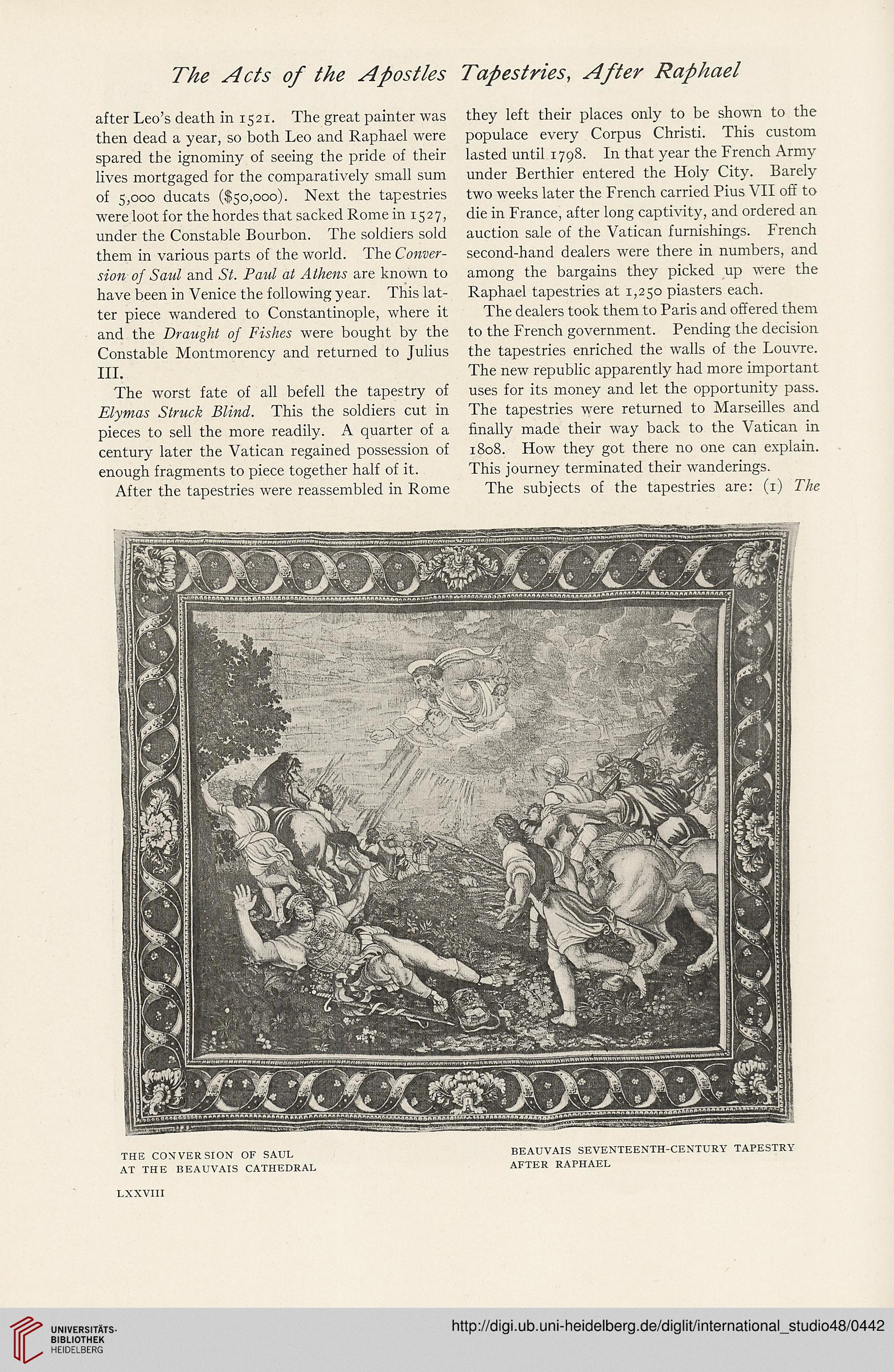The Acts of the Apostles
after Leo’s death in 1521. The great painter was
then dead a year, so both Leo and Raphael were
spared the ignominy of seeing the pride of their
lives mortgaged for the comparatively small sum
of 5,000 ducats ($50,000). Next the tapestries
were loot for the hordes that sacked Rome in 15 2 7,
under the Constable Bourbon. The soldiers sold
them in various parts of the world. The Conver-
sion of Saul and St. Paul at Athens are known to
have been in Venice the following year. This lat-
ter piece wandered to Constantinople, where it
and the Draught of Fishes were bought by the
Constable Montmorency and returned to Julius
III.
The worst fate of all befell the tapestry of
Elymas Struck Blind.. This the soldiers cut in
pieces to sell the more readily. A quarter of a
century later the Vatican regained possession of
enough fragments to piece together half of it.
After the tapestries were reassembled in Rome
Tapestries, After Raphael
they left their places only to be shown to the
populace every Corpus Christi. This custom
lasted until 1798. In that year the French Army
under Berthier entered the Holy City. Barely
two weeks later the French carried Pius VII off to
die in France, after long captivity, and ordered an
auction sale of the Vatican furnishings. French
second-hand dealers were there in numbers, and
among the bargains they picked up were the
Raphael tapestries at 1,250 piasters each.
The dealers took them to Paris and offered them
to the French government. Pending the decision
the tapestries enriched the walls of the Louvre.
The new republic apparently had more important
uses for its money and let the opportunity pass.
The tapestries were returned to Marseilles and
finally made their way back to the Vatican in
1808. How they got there no one can explain.
This journey terminated their wanderings.
The subjects of the tapestries are: (1) The
THE CONVERSION OF SAUL
AT THE BEAUVAIS CATHEDRAL
BEAUVAIS SEVENTEENTH-CENTURY TAPESTRY
AFTER RAPHAEL
LXXVIII
after Leo’s death in 1521. The great painter was
then dead a year, so both Leo and Raphael were
spared the ignominy of seeing the pride of their
lives mortgaged for the comparatively small sum
of 5,000 ducats ($50,000). Next the tapestries
were loot for the hordes that sacked Rome in 15 2 7,
under the Constable Bourbon. The soldiers sold
them in various parts of the world. The Conver-
sion of Saul and St. Paul at Athens are known to
have been in Venice the following year. This lat-
ter piece wandered to Constantinople, where it
and the Draught of Fishes were bought by the
Constable Montmorency and returned to Julius
III.
The worst fate of all befell the tapestry of
Elymas Struck Blind.. This the soldiers cut in
pieces to sell the more readily. A quarter of a
century later the Vatican regained possession of
enough fragments to piece together half of it.
After the tapestries were reassembled in Rome
Tapestries, After Raphael
they left their places only to be shown to the
populace every Corpus Christi. This custom
lasted until 1798. In that year the French Army
under Berthier entered the Holy City. Barely
two weeks later the French carried Pius VII off to
die in France, after long captivity, and ordered an
auction sale of the Vatican furnishings. French
second-hand dealers were there in numbers, and
among the bargains they picked up were the
Raphael tapestries at 1,250 piasters each.
The dealers took them to Paris and offered them
to the French government. Pending the decision
the tapestries enriched the walls of the Louvre.
The new republic apparently had more important
uses for its money and let the opportunity pass.
The tapestries were returned to Marseilles and
finally made their way back to the Vatican in
1808. How they got there no one can explain.
This journey terminated their wanderings.
The subjects of the tapestries are: (1) The
THE CONVERSION OF SAUL
AT THE BEAUVAIS CATHEDRAL
BEAUVAIS SEVENTEENTH-CENTURY TAPESTRY
AFTER RAPHAEL
LXXVIII




